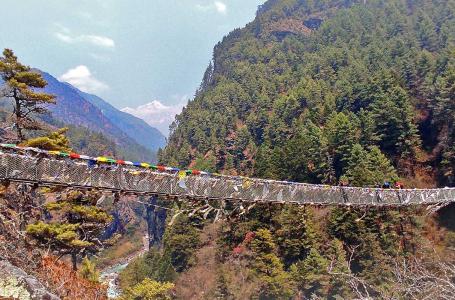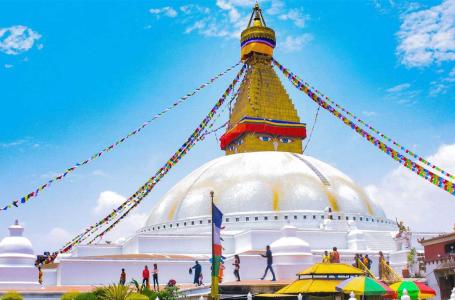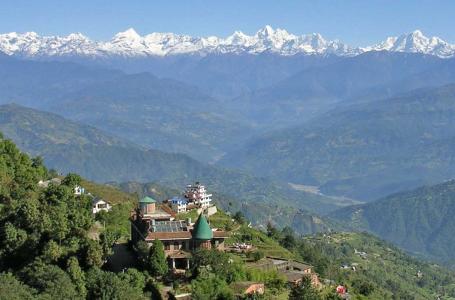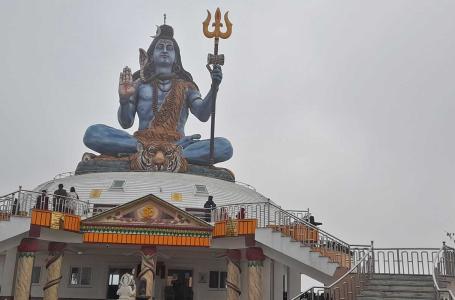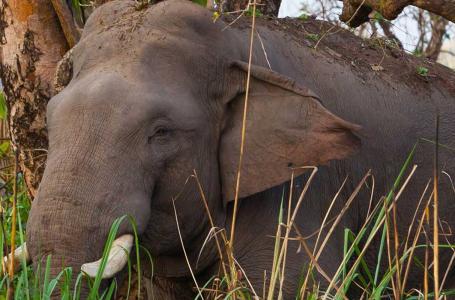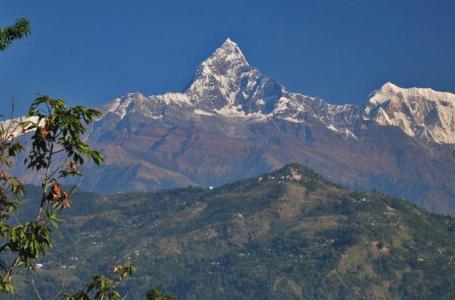The Dhaulagiri Round Trek, located in western Nepal, provides an exciting trip for trekkers looking to explore the distant and less-visited portions of the Annapurna and Dhaulagiri mountain ranges. This strenuous journey normally lasts 17 to 21 days, depending on the route and speed selected. The awe-inspiring vistas of Dhaulagiri I (8,167 meters) and neighboring peaks, as well as the exhilarating challenge of crossing high mountain, passes such as the French Pass (5,360 meters) and the Dhampus Pass (5,234 meters), reward trekkers with breathtaking panoramic views, contribute to its allure.
Aside from the natural beauty, the journey offers a rich cultural experience as it travels through local settlements, allowing trekkers to immerse themselves in the region's distinct traditions and lifestyles. This expedition, however, necessitates a high degree of physical endurance and acclimatization owing to the harsh terrain, high elevations, and lengthy trekking days. Proper permits, guides, and safety precautions are essential for a successful and safe Dhaulagiri Round Trek, which is best done in the spring and fall when the weather is steady and visibility is clear.
Planning a journey to Dhaulagiri, Nepal's highest mountain, is an exciting and hard task. To begin, extensively examine the Dhaulagiri journey, diving into its many routes, difficulty levels, and the necessary permits and documents. Create a well-planned itinerary by selecting a route such as the Dhaulagiri Circuit Trek or the Dhaulagiri Base Camp Trek. Your schedule might range from 12 to 18 days depending on your chosen path and walking pace. Consider hiring a local guide and porter, who may improve your experience, give useful insights, and help with logistics, leaving you to focus on enjoying the walk. Given the high heights and difficult terrain, adequate physical fitness is required, which necessitates previous training and cardiovascular conditioning.
This trip offers a spectacular tapestry of colors and smells throughout the spring (March to May). The weather remains steady, with pleasant temperatures during the day. Rhododendron woods blossom, providing a stunning background for your hike. Clear skies are common, allowing for unhindered views of the towering peaks.
Autumn (September to November) is another excellent option. This time follows the monsoon season and delivers dry and steady weather. The monsoon rains have left the paths lush and verdant, painting the scenery. The sky is consistently clear, allowing for breathtaking mountain views. The pleasant hiking conditions are made possible by the cold but comfortable temperatures.
The Dhaulagiri Round Trek is not suggested during the monsoon season or the summer season (June, July, and August). Furthermore, the cold of winter (December, January, and February) is intolerable for the average trekker.
The Dhaulagiri Trek is a challenging and adventurous journey through remote trails, high passes, and breathtaking landscapes. This trek is a fully camping-based expedition, meaning we carry all our essentials, including food and cooking gear. Our team of ten trekkers will set up tents and cook our meals, ensuring a self-sufficient and immersive experience in the Himalayas.
Cooking in the wild adds to the adventure. We prepare simple yet nutritious meals using local ingredients such as rice, lentils, vegetables, and noodles. Breakfast includes tea, chapati, or porridge, while dinner consists of hearty soups, pasta, or dal bhat. Campfires are rare due to altitude and weather, so we rely on gas or kerosene stoves.
The trek crosses challenging high passes like French Pass (5,360m) and Dhampus Pass (5,200m), leading to hidden valleys and glaciers. With no tea houses along the route, teamwork is key for setting up camp, cooking, and navigating rugged terrain.
This self-sufficient camping trek offers pure adventure, solitude, and stunning Himalayan views, making it an unforgettable experience for those seeking a true wilderness expedition.
Our journey often begins by taking a take a tourist bus to Pokhara. If you want a faster or private option then you can take a flight from Tribhuvan International Airport in Kathmandu to Pokhara. The road journey takes approximately 6 to 8 hours, depending on road conditions and if you go via flight then it will take around 30 mins to reach there and stay for the night. We will take a private vehicle or public vehicle Beni, which might take about 2 to 3 hours, depending on traffic and road conditions. Our drive continues from Beni to Darbang, which is the starting point of this trek. Once we finally reach Mudi, our trek begins on foot.
This trek concludes at Jomsom where you will catch a domestic flight back to Pokhara and from there you can easily find a tourist bus that will take you back to Kathmandu.
For trekking in the Dhaulagiri region of Nepal, you will need specific permits and documents to ensure you are compliant with local regulations.
1. Annapurna Conservation Area Permit (ACAP):
To visit the Annapurna area you must get an Annapurna Conservation Area Permit (ACAP). This protected area, noted for its breathtaking natural beauty, varied landscapes, and rich cultural history, is one of the most well-liked hiking areas in the nation.
Cost: Nrs 3000 per person
2. Trekker's Information Management System(TIMS):
For hikers in Nepal, the TIMS (Trekker's Information Management System) card is a necessary piece of identification. It was put into place to improve trekkers' safety and security while also assisting authorities in keeping track of travelers in various hiking locations.
Cost: Nrs 3000 per person for non SAARC tourists and Nrs 1000 for SAARC trekers.
(All the necessary permits are included in this package)
Upon arrival in Kathmandu, you'll be greeted by the vibrant energy of Nepal's capital city. Kathmandu is a melting pot of cultures, with ancient temples, bustling markets, and narrow alleyways waiting to be explored. Take some time to settle into your accommodation and immerse yourself in the sights and sounds of this historic city, perhaps sampling some traditional Nepali cuisine or browsing the colorful shops of Thamel.
Today is dedicated to preparing for your trek and exploring the cultural wonders of Kathmandu. After a hearty breakfast, you'll have the opportunity to rent or purchase any last-minute trekking gear you may need, ensuring you're fully equipped for the adventure ahead. In the afternoon, embark on a guided city tour to visit some of Kathmandu's most iconic landmarks, including ancient temples, palaces, and stupas. Learn about the rich history and religious significance of sites such as Kathmandu Durbar Square, Swayambhunath Stupa, and Boudhanath Stupa, gaining insights into Nepal's diverse cultural heritage.
Bid farewell to Kathmandu as you embark on a scenic drive or a short flight to Pokhara, known as the "City of Lakes." The journey offers breathtaking views of terraced fields, lush forests, and snow-capped mountains, providing a tantalizing glimpse of the natural beauty that awaits you in the Annapurna region. Upon arrival in Pokhara, take some time to relax by the tranquil waters of Phewa Lake, stroll along the lakeside promenade, or explore the vibrant markets and shops of Lakeside.
The journey from Pokhara to Mudi takes around 7-8 hours, starting with a drive to Beni along scenic mountain roads. From Beni, travelers switch to a local bus or jeep, as the rough, off-road trails lead toward Mudi. The route passes through terraced fields, dense forests, and traditional villages, offering breathtaking views of the Dhaulagiri range. Mudi, a remote Magar village, serves as the gateway to Dhaulagiri Base Camp treks. Though bumpy and challenging, the journey rewards travelers with stunning landscapes and warm village hospitality.
The trek from Mudi (1,850m) to Bagara is a scenic yet challenging journey through remote trails. The path descends towards a river before ascending along forested ridges and terraced fields. As you walk, enjoy breathtaking views of the Dhaulagiri range and surrounding hills.
The trail passes small settlements where locals practice traditional farming. Bagara (2,080m) is a peaceful village with limited facilities, making it essential to carry necessary supplies. The day’s trek offers an immersive experience in Nepal’s untouched landscapes, preparing for more remote sections ahead.
The trek from Bagara (2,080m) to Dovan is a challenging yet rewarding journey through dense forests and remote trails. The path gradually ascends and descends along narrow ridges, crossing small streams and wooden bridges.
The route becomes more isolated, with fewer settlements along the way. As you approach Dovan (2,520m), the vegetation thins, revealing stunning views of the Dhaulagiri region. Dovan is a small clearing in the forest, often used as a campsite for trekkers. With limited facilities, it’s essential to carry food and supplies. The peaceful surroundings make it a perfect resting spot before the next ascent.
The trek from Dovan (2,520m) to Sallaghari takes you deeper into the wilderness, following rugged trails through dense rhododendron and bamboo forests. The path gradually ascends, with occasional river crossings over wooden bridges.
As you gain elevation, the landscape becomes more alpine, with fewer trees and open grassy areas. Sallaghari (2,820m) is a small clearing surrounded by tall pine trees, often used as a campsite by trekkers heading toward Italian Base Camp. With limited facilities, it offers a peaceful overnight stop amidst nature, preparing for the higher altitudes ahead.
Set out on a challenging trek from Soligari to Italian Base Camp, located at the foot of the Dhaulagiri massif. The trail ascends steeply through rocky terrain and icy glaciers, with panoramic views of the surrounding peaks and valleys unfolding with each step. Italian Base Camp, nestled amidst towering cliffs and snow-covered slopes, offers a stunning backdrop for your overnight stay, with opportunities to explore the surrounding area and soak in the beauty of the Himalayas.
Take a well-deserved rest day at Italian Base Camp to acclimatize to the high altitude and prepare for the challenges ahead. Use this time to explore the area, take short hikes to nearby viewpoints, or simply relax and enjoy the serene beauty of the Himalayan wilderness. Acclimatization is essential for a safe and enjoyable trek, so listen to your body and take it easy as you adjust to the thin air and rugged terrain.
The trek from Italian Base Camp (3,660m) to Japanese Base Camp (3,890m) is a short but demanding journey through rocky terrain and glacial moraines. The trail gradually ascends, passing through landslide-prone areas and exposed sections with stunning views of Dhaulagiri and surrounding peaks.
As you approach the Japanese Base Camp, the air becomes thinner, and the landscape turns more rugged. This remote campsite offers basic shelter and serves as an important acclimatization stop before heading toward Dhaulagiri Base Camp. The breathtaking mountain scenery makes the challenging trek worthwhile.
The trek from Japanese Base Camp (3,890m) to Dhaulagiri Base Camp (4,740m) is a demanding journey across glacial moraines and rocky trails. The route passes through icy sections and steep ascents, requiring careful footing.
As you climb higher, the views of Dhaulagiri (8,167m) become more spectacular. The air is thinner, making slow and steady progress essential. Dhaulagiri Base Camp offers stunning glacier views and serves as a crucial acclimatization stop for trekkers and climbers.
Take another rest day at Dhaulagiri Base Camp to acclimatize to the high altitude and prepare for the crossing of the French Col. Use this time to explore the surrounding area, take short walks to nearby viewpoints, or simply relax and enjoy the peaceful atmosphere of the Himalayan wilderness. Acclimatization is essential for a safe and enjoyable trek, so take it easy and listen to your body as you prepare for the challenges ahead.
Embark on a challenging trek to Hidden Valley via the French Col, a high mountain pass located at an altitude of 5,360m. The crossing offers stunning views of the surrounding peaks and glaciers, with towering mountains and icy cliffs stretching as far as the eye can see. Hidden Valley, nestled amidst towering peaks and rocky cliffs, provides a surreal setting for your overnight stay, with opportunities to explore the surrounding area and marvel at the raw beauty of the Himalayas.
Continue your journey from Hidden Valley to Yak Kharka via Dhampus Pass, situated at an altitude of 5,200m. The trail takes you through rugged terrain and high mountain passes, with panoramic views of the surrounding peaks and valleys unfolding at every turn. Yak Kharka, a peaceful settlement nestled amidst alpine meadows and grazing pastures, offers a welcome respite for weary trekkers, with opportunities to relax and recharge before the final leg of your journey.
Descend from Yak Kharka to Jomsom, passing through picturesque villages and terraced fields. Jomsom is a bustling town located on the banks of the Kali Gandaki River, known for its apple orchards and traditional Tibetan culture. Explore the town and soak in the sights and sounds of this vibrant Himalayan settlement, with opportunities to visit local markets, monasteries, and temples.
Bid farewell to the mountains as you take a scenic flight or a drive from Jomsom to Pokhara. The journey offers breathtaking views of the Annapurna and Dhaulagiri ranges, with towering peaks and snow-capped mountains stretching as far as the eye can see. Pokhara, with its serene lakes, lush forests, and vibrant culture, offers a perfect setting to relax and unwind after your trek.
Embark on a short flight or a scenic drive from Pokhara to Kathmandu, marking the end of your Dhaulagiri Round Trek. Reflect on your journey and cherish the memories of the breathtaking landscapes, rich cultural heritage, and unforgettable experiences that you encountered along the way. Upon arrival in Kathmandu, take some time to explore the city one last time, perhaps indulging in some souvenir shopping or sampling some delicious Nepali cuisine.
Bid farewell to Nepal as you prepare to depart for your onward journey. Take one last stroll through the bustling streets of Kathmandu, savoring the sights, sounds, and flavors of this vibrant city before saying goodbye to the land of the Himalayas. Reflect on the memories of your trekking adventure and the friendships forged along the way, knowing that you've experienced the beauty and magic of the Himalayas in all its glory.
Trip Start and End Point
Kathmandu / Kathmandu
| DATES | STATUS | PRICE | SPACE LEFT | ||||
|---|---|---|---|---|---|---|---|
|
Start date: 15-May, 2025
End date: 01-Jun, 2025 |
Guaranteed | USD 3130 |
2
|
Book Now | |||
|
Start date: 09-Jun, 2025
End date: 15-Jun, 2025 |
Guaranteed | USD 3130 |
3
|
Book Now | |||
|
Start date: 25-Jun, 2025
End date: 12-Jul, 2025 |
Guaranteed | USD 3130 |
2
|
Book Now | |||
|
Start date: 10-Aug, 2025
End date: 27-Aug, 2025 |
Guaranteed | USD 3130 |
2
|
Book Now | |||
|
Start date: 15-Aug, 2025
End date: 24-Aug, 2025 |
Guaranteed | USD 3130 |
1
|
Book Now | |||
|
Start date: 25-Sep, 2025
End date: 01-Oct, 2025 |
Guaranteed | USD 3130 |
2
|
Book Now | |||
|
Start date: 05-Oct, 2025
End date: 22-Oct, 2025 |
Guaranteed | USD 3130 |
1
|
Book Now | |||
|
Start date: 02-Nov, 2025
End date: 19-Nov, 2025 |
Guaranteed | USD 3130 |
2
|
Book Now | |||
|
Start date: 25-Nov, 2025
End date: 12-Dec, 2025 |
Guaranteed | USD 3130 |
2
|
Book Now | |||
This trek is one of the most remote in Nepal, with few villages, no teahouses beyond Italian Base Camp, and long stretches of wilderness. Camping is required for several days.
Trekkers need to cross the Chhonbardan Glacier and sections of the Dhaulagiri Glacier. Some areas require basic mountaineering skills, including walking on ice and snow with crampons. Guides provide safety support.
No, the Dhaulagiri Round Trek is not recommended for solo trekkers due to its remoteness, glacier crossings, and extreme conditions. A guide and porter are strongly advised.
Key gear includes crampons, ice axe, gaiters, down jacket (-20°C rating), four-season tent, and high-quality sleeping bag. Proper mountaineering equipment is needed for the high passes.

